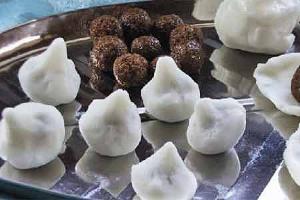Hindu festival cuisine
| Line 16: | Line 16: | ||
'''Hindu festival cuisine''' | '''Hindu festival cuisine''' | ||
| + | |||
[http://timesofindia.indiatimes.com/ timesofindia.indiatimes] | [http://timesofindia.indiatimes.com/ timesofindia.indiatimes] | ||
Revision as of 10:16, 15 December 2013
This is a collection of articles archived for the excellence of their content. Readers will be able to edit existing articles and post new articles directly |
Hindu festival cuisine
Contents |
Ganesh Chaturthi
The sweet served on the occasion is variously known as Modak (Maharashtra) / Manda Pitha (Orissa)/ Modakam / Kozhukatta / Kolukattai.
Kozhukattai
Snack on kozhukattais this Ganesh Chaturthi
Srinivasa Ramanujam & M Suganth, TNN | Sep 19, 2012
This Ganesh Chaturthi, it's time for you to devour that favourite snack
What's Vinayaka Chaturthi without some kozhukattai? This special snack that's on everybody's lips (and mouths) on Lord Ganesha's special day is something that everybody looks forward to this time of the year.
For HR professional Sriram Parthasarathy, though kozhukattai is a healthy and tasty snack on any day, it's the occasion that makes it all the more special. "I can't stop myself from gorging on them during Vinayaka Chaturthi as it is made extra special on that day," he says.
For danseuse Saraswathi, Ganesha is her favourite deity and this is an occasion that she looks forward to. Apart from the poojas and the devotional aspect, it's the mention of kozhukattais that bring a smile to her face. "We don't normally make kozhukattais, especially the sweeter version, at the house. So we just devour it during this occasion," she adds.
With times changing, the varieties of kozhukattai made have also changed a lot. Ask Chef Damu about it and he says, "There have been some fancy ones also of late. At a recent event, I was pleasantly surprised to find a 'medicinal kozhukattai' — which has been made with the use of some natural ingredients. This is said to be tasty and also good for the health which makes it an ideal snack." There are other newer versions for the kozhukattai as well.
Says Chef Jacob Sahaya Kumar, "Like the many forms of Lord Vinayaka, there are many fancy varieties of kozhukkattai today — sandwich kozhukattai, idli kozhukattai, cheese ball kozhukattai, waffle kozhukattai and so on. We can even make a cake kozhukattai. Anyone can try making different kozhukattais just by making the 'choppu' in different forms. Instead of the regular shell shape, one can try going for shapes like suitcase, conch, bucket and even snake and garland (which can be used to decorate the idol)." So, if you're trying out some kozhukattais today, you know what to do!
On the food trail
Until the 3rd century, people didn't have utensils in a proper form as we have today and so, even the food that they made took any convenient form and the shell shape (which we use for kozhukkatai) was one of the most used.
Though there is no instance of the epics quoting that Lord Vinayaka likes kozhukkatai, there is a mythological story to illustrate his love for the food item. He loved it so dearly that once, he swallowed Lord Vishnu's chakra taking it for a kozhukattai. Despite the pleas of Vishnu, he refused to give it back and Vishnu finally did thoppukaranam. Seeing that, Vinayaka started laughing and with his mouth open, the chakra returned to its rightful owner.
Some recipes to prepare kozhukattai
Kozhukattai
What you'll need
Oru (one) azha arisi maavu, Rendu (two) azha water, 3 teaspoons of salt, four teaspoons with oil, one tenga moodi, 150 grams of vellam and 6 yelakkas.
What to do:
-Heat four teaspoons of oil in a kadai.
-Also, add sufficient water and required salt to the arisi maavu and heat it simultaneously till it becomes a fine dough mixture. Alternatively, you can also steam it in a cooker to get the required texture.
-Meanwhile, mix the grated coconut and jaggery with little water and heat it in low flame till it solidifies. Add cardamom for flavour.
-Take the prepared dough balls and spread each ball onto your palm to flatten it. Use the heated oil to avoid the dough getting stuck onto your palm. Place a little bit of the poornam mixture in between the flattened dough and shape it like a cone or a dome. This is your kozhakattai!
-Steam the kozhakattai, and serve it hot!
Rava kozhukattai
What you'll need for fried rava kozhukattai:
For 'Choppu' — White rava - 100 g, Raw rice flour - 25 g
For 'Poornam' — Jaggery water - 100 ml
Grated coconut - Half
Cardamom powder - a pinch
What to do
-Sprinkle water on the rave and leave it to soak for a few minutes till it becomes a paste.
-Thicken the paste by using rice flour and set it aside.
-Heat the jaggery water (paagu) until it caramelizes.
-Add grated coconuts and cardamom powder.
-Leave this on stove for close to two minutes and later, let it cool.
-When the poornam has cooled, divide it into small portions.
-Make shells out of the rava and rice paste and fill them with poornam.
-Heat ghee in a pan and fry the stuffed shells.
It is believed that Lord Vinayaka likes fried kozhukattais and it is a ritual in some places to offer him at least two while performing puja.
